‘Inveraray Downs’
Higher quality food through regenerated soil + reduced inputs
A REGENERATIVE AGRICULTURE CASE STUDY
 To overcome productivity declines in some of Australia’s best soils, Cam and Roxane McKellar have re-designed ecological cropping practices, successfully regenerating the structure and nutrient dynamics in their soils. As a result, they now produce better quality and more healthy and nutritious food more sustainably and with lower inputs.
To overcome productivity declines in some of Australia’s best soils, Cam and Roxane McKellar have re-designed ecological cropping practices, successfully regenerating the structure and nutrient dynamics in their soils. As a result, they now produce better quality and more healthy and nutritious food more sustainably and with lower inputs.
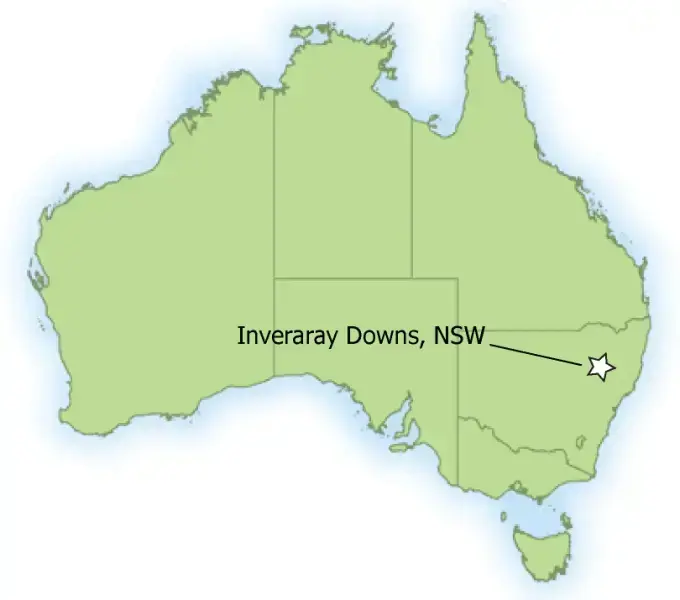
10 km south of Spring Ridge, NSW North West Slopes and Plains
ENTERPRISE: Crops. Cattle. Compost. Irrigated grain, seed and legume crops; cattle agistment; organic compost
PROPERTY SIZE: 1250 hectares, 810 hectares irrigated crop production
AVERAGE ANNUAL RAINFALL: 6800 mm
ELEVATION: 330 m
MOTIVATION FOR CHANGE: Prohibitively high-input crop production system
INNOVATIONS
- Changing crop rotation to better support soil biology
- Changing from inorganic to organic fertilisers
- Application of compost fertiliser to increase soil organic matter
- Integrating grazing with cropping
- Innovations commenced: 2000
KEY RESULTS
- Regeneration of soil and nutrient dynamics
- Improved crop quality, increased weight and more even yields across the property
- Reduced input costs
- Additional revenue from compost sale and cattle agistment
Introduction
On Inveraray Downs, Cam and Roxane grow grains – wheat, sorghum, various types of corn, sunflower and barley – and other crops, such as chick peas, mung beans and soy beans. Decades of standard management practices such as cultivation, inorganic fertiliser and bio-cide use had degraded the quality and productivity of some of Australia’ best soils on the Liverpool Plains. Essential biological processes and cycles for supplying nutrients to crops had been degraded, pest infestations were high and input costs were increasing.
Cam and Roxane started investigating alternatives to the high-input crop production system, investing time and money to eventually determine that the solution was to work with the soil’s biological activity rather than against it. To achieve this, Cam re-designed ecological cropping systems and successions to restore the soil’s natural high carbon levels, healthy structures, nutrient availabilities and hydrological resilience. Organic matter and nutrients from clean agricultural wastes are also being recycled back into the soils via the on-farm production and use of high quality composts.
Combined with their organic composts and crop rotation the McKellars have also introduced cattle into their systems to break down crop stubble, recycle green manure crops and add fertiliser. As a result Inveraray Downs’ production costs have decreased, crop yields and qualities have improved and the structure, fertility and resilience of soils are being restored.
The old way: From Stocks to Crops
Inveraray Downs is a small part of the Warrah Estate, a land holding of some 100,000 hectares that was granted to the Australian Agricultural Company in 1833. The McKellar family bought Inveraray Downs in 1962 and Cam McKellar is the second generation of the family to manage the property.
The deep, heavy clay soils (vertisols) which are widespread in the Liverpool Plains region, have high natural fertility. Derived on basalt plains, the vertisols had long been treeless. Denser forests of cypress pine (Callitris endlicheri) with scattered eucalypts typically occur on the sandier soils on the ridges and slopes rising from the plains.
The plains native vegetation is ideal for sheep grazing, which was the main farm business up to the 1960s. Severe drought followed by a period of anecdotally cooler weather in the mid 1960s caused massive loss of sheep. This, together with the declining returns from grazing, forced a re-thinking of the farm business. A bore found readily accessible water for crop irrigation. Additionally, by this time, tractors capable of cultivating the heavy clay soils were readily available. Grazing was phased out and re-development of the property for irrigated crop production proceeded through the late 1960s.
Flood irrigation was introduced in 1970. Whilst the total property area is 1250 hectares, about 810 hectares can be irrigated for crop production. Water, from either or both a bore and the intermittently flowing Yarraman Creek that runs though the property, when flow is sufficient, is pumped into a large ‘turkey nest’ earth tank. From here it can flow by gravity to the crops via earth channels. The average slope across the property is about 1:600. Water from the channels is diverted into the crops down furrows, ploughed at two metre spacing, down the length of each crop field. The furrows are sufficiently close together that sideways infiltration wets the plant root zone.
Cam says, “No fertiliser was used until the early 70s as it was naturally very fertile”. However, in line with common cropping techniques, chemical fertiliser, pesticide and herbicide use eventually became common practice.
The farming practices typical of the period from the 1970s can be illustrated using a three-year cropping calendar. The main features of this former calendar include in years one and three growing corn over summer and autumn, burning the stubble in autumn and growing a legume during winter and spring. In the second year a legume is grown in summer and autumn followed by a fallow in winter.
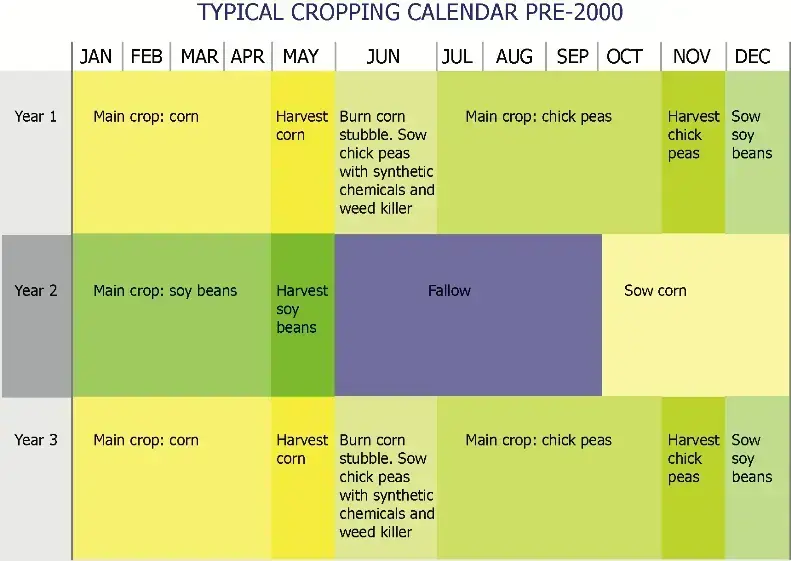
Summer and winter cropping continued for the following decades, using the “best management practices” of the day. However, years of cultivation, inorganic fertiliser and bio-cide use resulted in productivity declines in what were some of Australia’s best soils. Essential biological processes and cycles for supplying nutrients to their crops had degraded. By 1985, Cam suspects that the soil organic matter level had declined from an original level of perhaps 5% to 0.5%. It took Cam a further ten or so years to realise that “… it was stuffed! The worms had gone. Pests were rife. We were on a high input treadmill and couldn’t get off”.
At the same time, the costs of inputs – fertilisers, fuel, pesticides and herbicides – were becoming prohibitive. Cam recalls, “We were going broke. Everyone but me was making money out of the farm!”
Swapping Chemical for Organic Fertiliser
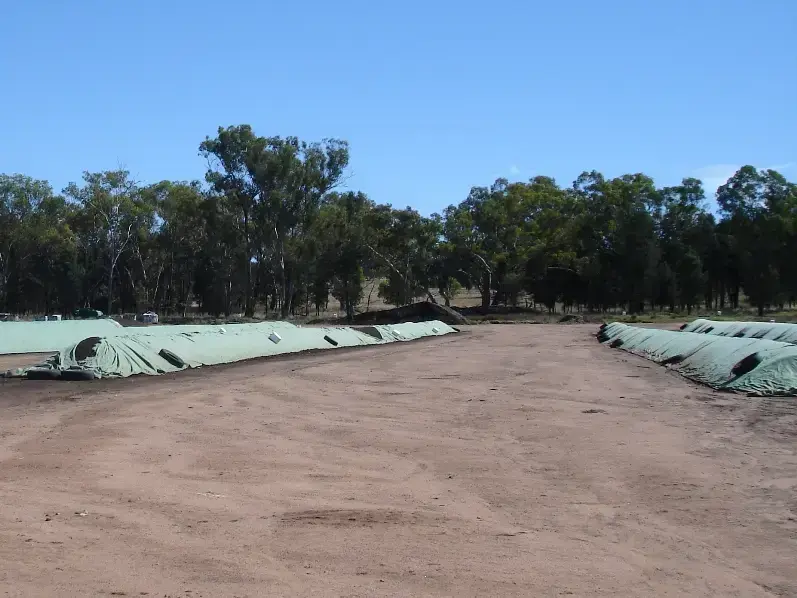
Compost heaps under Gore-Tex sheets.
The McKellars started investigating alternatives to the high-input crop production system. Cam invested thousands of dollars in education, in Australia and overseas. This included a Holistic Management Course and an Arden Anderson Soil Course, various composting courses and seminars. Cam received a Nuffield Scholarship in 1991 and this enabled him further opportunity to study and develop ideas for innovative cultivation and cropping practices.
Cam identified that, “Fundamentally we need to work with nature, not against her. The soil health holds the key, and that is enhanced by the biological activity occurring in the soil and its interaction with the plants/crops”.
As a major innovation, Cam gradually started adopting new practices, changing from costly inorganic fertilisers to organic fertilisers. He slowly reduced the reliance on traditional fertilisers and swapped them for other options, such as kelp, fish emulsions and composts. He experimented by purchasing or obtaining for the cost of transport a range of materials, such as wastes from cattle feedlots, horse stables and chicken breeders, decayed hay and whatever other organic matter was available. It took a lot of effort to learn the methods used to produce compost fertiliser from organic wastes and by-products.
Cam summarises the rationale, “Through improved structure and organic matter content, the soil holds more water, being available to plants and animals for longer”.
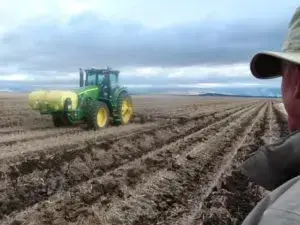
Distribution of organic liquid fertiliser.
Now, these organic materials are brought to the compost production facility, which comprises about four hectares of gently sloping ground, an overhead tank for water supply, a tractor to tow the compost turner to form compost heaps and a front-end loader to move the materials around.
The various raw materials are mixed in carefully managed proportions to achieve the carbon to nitrogen ratio necessary to facilitate aerobic microbiological decomposition. The mix is formed into beds about a metre high, two metres wide and one hundred metres long. These are covered with Gore-Tex sheets that enable water to evaporate while preventing rainfall from infiltrating, so that moisture content in the bed is controlled. The temperature and CO2 levels within the beds are monitored daily and the whole bed turned over and re-formed when benchmark levels are reached. The on-farm composting capability is managed by one full time employee.
The resulting compost is spread across the crop fields at a rate of 4 tonnes per hectare each year
Through this activity Cam and Roxane have also generated an additional source of income. Cam reports, “I can sell compost by the ute load or the truck load to those who are keen to try it for themselves”.
Now, these organic materials are brought to the compost production facility, which comprises about four hectares of gently sloping ground, an overhead tank for water supply, a tractor to tow the compost turner to form compost heaps and a front-end loader to move the materials around.
The various raw materials are mixed in carefully managed proportions to achieve the carbon to nitrogen ratio necessary to facilitate aerobic microbiological decomposition. The mix is formed into beds about a metre high, two metres wide and one hundred metres long. These are covered with Gore-Tex sheets that enable water to evaporate while preventing rainfall from infiltrating, so that moisture content in the bed is controlled. The temperature and CO2 levels within the beds are monitored daily and the whole bed turned over and re-formed when benchmark levels are reached. The on-farm composting capability is managed by one full time employee.
The resulting compost is spread across the crop fields at a rate of 4 tonnes per hectare each year
Through this activity Cam and Roxane have also generated an additional source of income. Cam reports, “I can sell compost by the ute load or the truck load to those who are keen to try it for themselves”.
The new way: Mixing Stocks with Crops
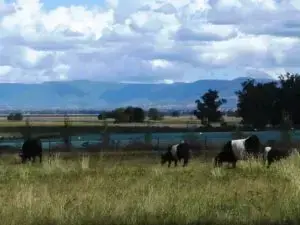
Grazing Belted Galloway cattle in front of compost heaps.
The other major innovation on Inveraray Downs was to change crop rotation practices and to opportunistically use cattle after cropping to break down stubble and to recycle green manure crops. The Belted Galloway cattle were reintroduced to the enterprise in 2000 and now provide an additional source of fertiliser and revenue.
“I am using cattle as quick stubble digesters – they are eating the sorghum and corn stubble, which keeps the soil microbes thriving while we get ready to sow the next crop.” Agisting cattle, rather than maintaining a herd on the property, allows them to be used when it suits the crop production cycle.
Cam re-designed ecological cropping systems and successions to restore the natural high soil carbon levels, soil structures, nutrient availability and the hydrological resilience of these soils. These practices include direct drilling of crops, use of green manure and the recycling of organic matter and nutrients from clean agricultural wastes back into the soils via the on farm production and use of high quality composts.
The farming practices that are now typical of the McKellar’s farming system since 2006 can be summarised using a three-year cropping calendar. The obvious difference with the earlier calendar is that stubble burning has been replaced by incorporating the stubble and compost into the soil. Green manure crops are now grown in the first and third years. Every year in spring or early summer a brief two-month fallow is provided. The fallow periods provide time for the soil microbes to decompose the green manure, and therefore for the nutrients to be released for use by the next crop.
“When you compare the two cropping calendars, before 2000 with after 2006, you see more flexibility in what we are doing now. Our farming practices are much kinder on the organisms living in the soil”, Cam explains.
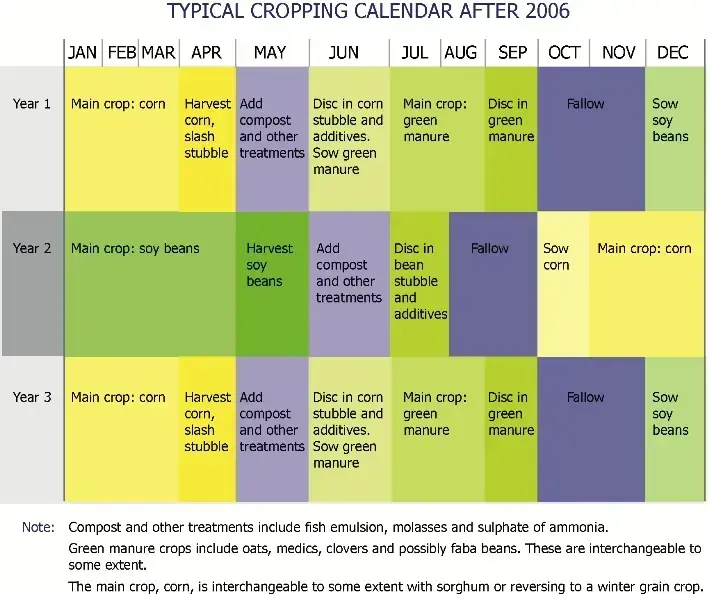
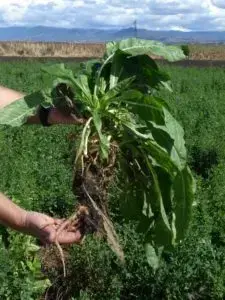
Chicory (Cichorium intybus) tap roots penetrate deeply, drawing nutrients from lower in the soil.
Because irrigation farms don’t usually need the fencing necessary on grazing properties, Cam had to find a way to control the stock without getting in the way of cropping. Portable electric fencing was found to be the most cost-effective way. To get the maximum stubble recycling and trampling benefit from grazing, he uses a grid of electric tapes to confine the herd to one-hectare cells. The herd is moved to the next cell each day. This ensures that the cows either recycle the stubble and turn it into manure or pound it into the soil, where the soil biota such as insects, micro-fauna, worms, bacteria, fungi and other microbes can do their work of breaking down the organic matter to release the nutrients.
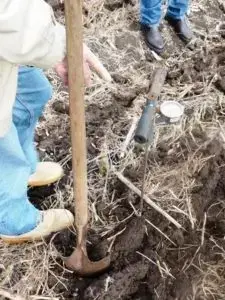
A penetrometer test shows deep, friable soil.
The same high intensity grazing approach is used to treat green manure crops. These crops are legumes grown for their nitrogen-fixing capacity, rather than as a cash crop. Before they go to seed, cattle are used to turn the foliage into manure and to break down the residues into mulch, in the same way that crop stubble is treated.
The effect after several seasons is a vastly improved soil structure, organic matter content and balance within the cation exchange capacity, and a soil that provides a better growing medium and holds more water. The evidence of soil structure improvement can be easily seen with a simple probe test.
This process has meant that, in the McKellar’s experience, insecticides and fungicides have virtually been eliminated from the cropping cycle. Cam recognises that “weeds do have a role to play as both indicators and a ‘home’ for microbiological activity. The improved resilience of the soils allows for the weeds to be left longer before being managed”.
Now, the preferred method to control pests and weeds is to use the winter-summer crop rotation and cultivation that breaks the weed regeneration cycle. It has not been practical to eliminate use of chemical herbicides completely, but the volume used has considerably reduced. Cam notes, “Weed spectrum changes with farming culture, however, summer and winter broad leaves and grasses are main challenge, especially [those that are] Glyphosate resistant”.
Into the Future
I should have moved to a more natural system of farming a lot earlier in my life. It is not that hard.
Cam and Roxane’s re-designed ecological cropping practices that have successfully regenerated what were some of Australia’s best soils, particularly the soil structure and nutrient dynamics in their soils. As a result, they now produce better quality and more healthy and nutritious food more sustainably and with fewer inputs.
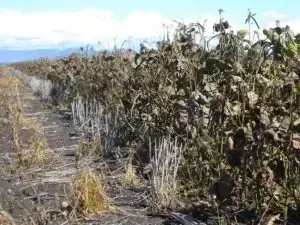
Wheat stubble from the previous grain crop is still visible among the ready-to-harvest mung beans.
The crop rotation system now used on Inveraray Downs is more complex than the traditional one, however, organic fertiliser made on the property has replaced chemical fertilisers and herbicide and pesticide use is much reduced. The cash inputs required have therefore decreased substantially.
Of what has been the greatest impact of these changed practices, Cam says, “Definitely building soil carbon (organic matter), enhanced microbial activity to enhance the robustness of crops and pastures and more efficient water holding capacity”.
As a result of the changes made on Inveraray Downs, grain quality has improved, the colour and ‘plumpness’ is noticeably better and bushel weight has increased. Yields are even across the property and there is less disease. As Cam says, “It’s about increasing the fertility of the soil, improving yields and producing better quality food”.
Cam and Roxane feel that overall the changes on Inveraray Downs have been very positive, but acknowledge that there is more to do. Priority activities include:
- continue to build soil humus levels
- re-mineralise the soil
- improve plant and animal nutrition
- increase livestock numbers
Looking into the future Cam notes, “My biggest risk in the enterprise remains the markets for my crops. As these fluctuate, I must seek to find efficiencies in the inputs applied. To that end, I am routinely applying biological amendments that are cheaper per hectare than conventional equivalents,”.
In recent years Cam has left a buffer strip along the creek, which is no longer cropped. “I refer to this as my biodiversity patch. Over time I have observed new and different types of plants in the strip. Every few months I turn the cattle in there for a few days just to knock down some of the weeds.”
These buffer zones around the perimeter of the farm are now managed for timber and biodiversity. Numerous signs of increased biodiversity can be observed across the property. Macro and micro soil life has returned. Insects are abundant. Kites, kestrels, hawks and eagles have returned, showing that there are ample small animals around to support them.
Soil microbial activity has been enhanced through the cycle of decomposition of organic matter that releases and makes these nutrients available. Cam notes, “I use worms as an indicator of how healthy my soils are. Worms can now be found anywhere you dig”.
Cam concludes, “I should have moved to a more natural system of farming a lot earlier in my life. It is not hard. Start small, experiment, then expand”.




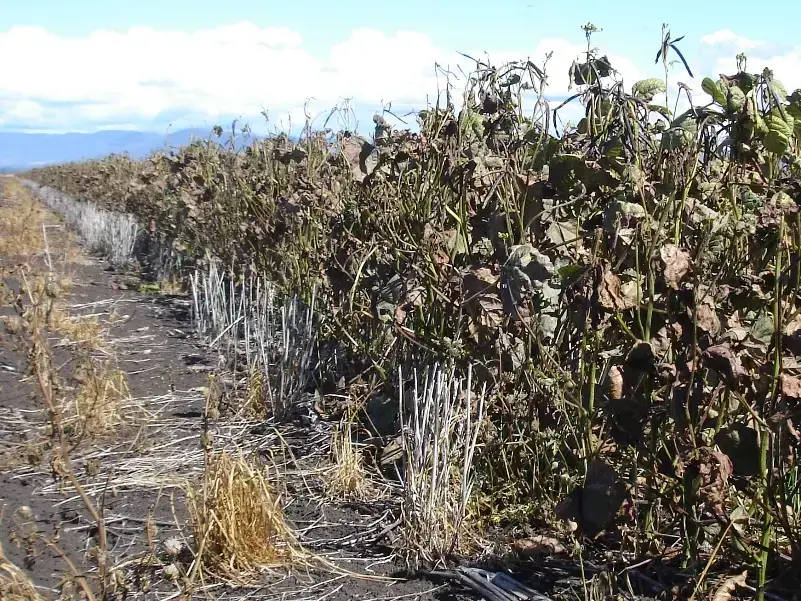
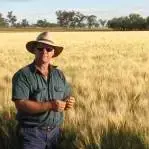 To overcome productivity declines in some of Australia’s best soils, Cam and Roxane McKellar have re-designed ecological cropping practices, successfully regenerating the structure and nutrient dynamics in their soils. As a result, they now produce better quality and more healthy and nutritious food more sustainably and with lower inputs.
To overcome productivity declines in some of Australia’s best soils, Cam and Roxane McKellar have re-designed ecological cropping practices, successfully regenerating the structure and nutrient dynamics in their soils. As a result, they now produce better quality and more healthy and nutritious food more sustainably and with lower inputs.
